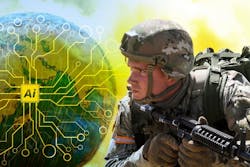Military researchers to brief industry on designs for energy-efficient machine learning on the battlefield
Questions and answers:
- What is DARPA’s ML2P program about? It aims to create energy-efficient machine learning technologies that can operate in resource-constrained battlefield environments.
- Why is energy efficiency critical for battlefield machine learning? Today's machine learning technologies consume large amounts of electricity, which could overwhelm the limited power available from batteries and generators in combat zones.
- When and where will DARPA brief industry on ML2P? From 9 a.m. to 3 p.m. Tuesday 26 Aug. 2025 at the DARPA Executive Conference Center in Arlington, Va., and also will be available online for registered participants.
ARLINGTON, Va. – U.S. military researchers will brief industry next week on a new program to develop energy-efficient machine learning capabilities for use in austere environments on the leading edge of the battlefield.
Officials of the U.S. Defense Advanced Research Projects Agency (DARPA) in Arlington, Va., will brief industry in person and online on the Mapping Machine Learning to Physics (ML2P) program from 9 a.m. to 3 p.m. on Tuesday 26 Aug. 2025.
ML2P seeks to develop an innovative, sustainable approach to power-hungry battlefield machine learning that does not hog the limited electricity on the battlefield that typically comes from batteries and generators.
In-person briefings will be at the DARPA Executive Conference Center, 4075 Wilson Blvd., in Arlington, Va. Attendees will receive log-on credentials for online virtual briefings when they register.
Overwhelming power demand
Machine learning technology today uses an inordinate amount of electricity, which could overwhelm current power generation and storage capabilities on the battlefield. The ML2P program seeks to make machine learning technologies that energy-efficient enough for the limited resources of the battlefield.
To sustain innovation without compromising energy resources, the ML2P program seeks to develop an innovative and sustainable approach to machine learning.
Machine learning at the edge operates in a resource-constrained battlefield, which requires electrical efficiency. The solution could involve new generations energy-aware machine learning.
DARPA researchers expect to borrow technological approaches to energy use from air-, land-, and sea-based uncrewed vehicles, which have limited battery capacities that must serve mission needs that include propulsion, communications, data processing, and mission planning.
Tell me more about the need for machine learning on the battlefield ...
- Driving the need for machine learning on the battlefield is the increasing complexity, speed, and data-driven nature of modern warfare. Machine learning on the battlefield lends itself to fast decision-making; alleviating data overload; enhanced target recognition and tracking; machine autonomy; cyber security and electronic warfare (EW); predictive maintenance and logistics; and psychological and information warfare. Machine learning -- especially large-scale deep learning -- burns through a lot of electricity because it’s doing a mind-boggling amount of math quickly across thousands or millions of parameters and training examples.
The ML2P program seeks to enable accurate predictions of the power and performance of future machine learning models that understand power consumption throughout the machine learning life cycle. This will drive development of more energy-efficient military computing, researchers say. ML2P will build energy-aware machine learning that provides trade-offs between power and performance to enable energy-aware machine learning.
Those interested in attending the in-person and online virtual ML2P briefings should register no later than 5 p.m. on Monday 25 Aug. 2025 online at https://creative.spa.com/darpa/i2o/ml2p/pd/?p=registration. Attendance is free for registrants.
Email questions or concerns to DARPA at [email protected]. More information is online at https://sam.gov/opp/aaba444f0eb8450a8ad430a28c595d36/view.
About the Author
John Keller
Editor-in-Chief
John Keller is the Editor-in-Chief, Military & Aerospace Electronics Magazine--provides extensive coverage and analysis of enabling electronics and optoelectronic technologies in military, space and commercial aviation applications. John has been a member of the Military & Aerospace Electronics staff since 1989 and chief editor since 1995.
